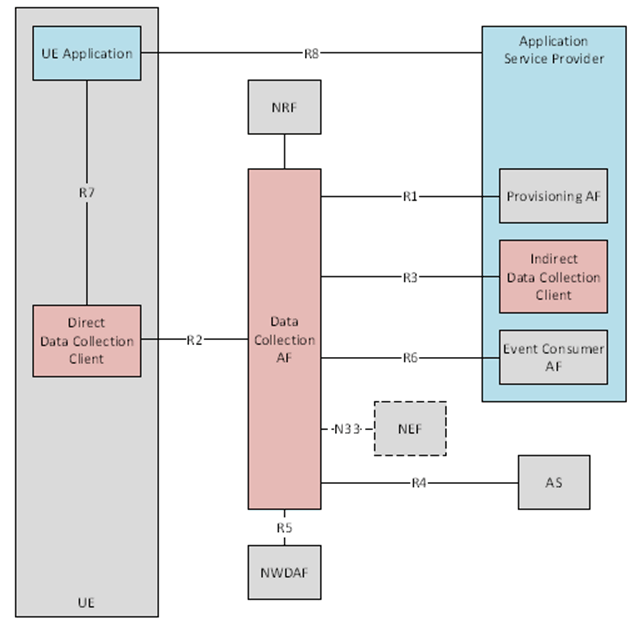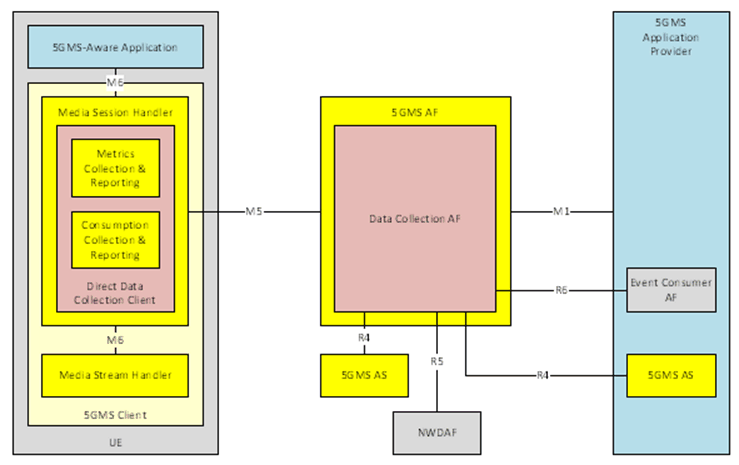Content for TR 21.917 Word version: 17.0.1
0…
5…
5.2
6…
6.3…
6.3.2…
6.3.3…
6.3.4…
7…
7.4…
8…
9…
10…
11…
11.9…
12…
13…
14…
15…
15.6…
16…
17…
18…
18.10…
19…
15.6 Media Streaming AF Event Exposure
15.7 Restoration of PDN Connections in PGW-C/SMF Set
15.8 Other media and user plane aspects
...
...
15.6 Media Streaming AF Event Exposure p. 136
| UID | Name | Acronym | WG | WID | WI rapporteur name/company |
|---|---|---|---|---|---|
| 920008 | 5GMS AF Event Exposure | EVEX | S4 | SP-210374 | Lo, Charles, Qualcomm Inc., |
| 920009 | Edge Extensions to the 5G Media Streaming Architecture | 5GMS_EDGE | S4 | SP-210375 | Bouazizi, Imed, Qualcomm Inc. |
Summary based on the input provided by Qualcomm in SP-220635
This work item [1] relates to the support of generic UE data collection, reporting and event exposure, and the 5G Media Streaming instantiation of the generic functionality. It is related to two other 3GPP Rel-17 work items:
The SA4 specifications on UE data collection, reporting and event exposure describe and define the mechanisms whereby different types of data collection clients, such as a UE, an application server in the network, or a server entity of an Application Service Provider, to collect and report a variety of application-level UE information, in accordance with their respective configurations, to a Data Collection AF (Application Function). The Data Collection AF can subsequently process its collected UE data to be offered, as Event Exposure services, to external entities for device, network and service performance monitoring and data analytics purposes.
The system architecture, reference points, and high-level procedures regarding generic UE data collection, reporting and event exposure are described in the stage 2 specification TS 26.531. The stage 3 specification TS 26.532 defines the detailed procedures and associated APIs for the generic UE data collection and reporting functionality.
Figure 15.6-1 depicts the generic UE data collection, reporting and event exposure architecture.
- SA2 work item "eNA_Ph2" with regards to UE data collection and event exposure by an AF to event consumers such as the NWDAF, and
- CT3 work item "EVEX" with regards to extending relevant stage 3 specifications in support of event exposure and NEF mediation of interactions pertaining to UE data collection, reporting and event exposure functionality specific to 5G Media Streaming.

Figure 15.6-1: Reference architecture for generic UE data collection, reporting and event exposure
(⇒ copy of original 3GPP image)
(⇒ copy of original 3GPP image)
The functional entities and reference points pertaining to EVEX in Figure 15.6-1 are described below:
Instantiation of the generic UE data collection, reporting and event exposure architecture for 5G Media Streaming is specified in TS 26.501, as shown in Figure 15.6-2.
- Data collection clients including the Direct Data Collection Client in the UE, Indirect Data Collection Client of the Application Service Provider, and the AS (Application Server, which contains and delivers user plane data to end-user devices). These entities obtain their UE data collection and reporting configuration from, and reports collected UE data to, the Data Collection Client, at the R2, R3 and R4 reference points, respectively.
- Data Collection AF - This entity is provisioned with its UE data collection, reporting and event exposure configuration by the Provisioning AF of the Application Service Provider at the R1 reference point. It utilizes that information to provide data collection and reporting configuration(s) to relevant data collection clients. Subsequently, the Data Collection AF processes UE data reports received from the data collection client(s) for event exposure services to eligible consumer entities (e.g., the NWDAF and Event Consumer AF of the Application Service Provider, at reference points R5 and R6, respectively) according to its event exposure restriction configuration.
- Provisioning AF - This entity provisions the Data Collection AF with UE data collection, reporting and event exposure information via reference point R1. A portion of that configuration information is intended to be forwarded by the Data Collection AF to data collection clients.
- UE Application - This optional entity in the UE, if instantiated, is responsible for interacting with the Direct Data Collection Client, via reference point R7, to obtain a UE data collection and reporting configuration, and subsequently send collected UE data reports to the Direct Data Collection Client to be in turn reported to the Data Collection AF.
- NEF - This entity is optionally present to mediate the configuration, reporting and event exposure related interactions between associated pairs of the above-described entities when those reside in separate trust domains.

Figure 15.6-2: Instantiation of generic data collection, reporting and event exposure for 5G Media Streaming
(⇒ copy of original 3GPP image)
(⇒ copy of original 3GPP image)
As shown in Figure 15.6-2, the Data Collection AF is instantiated as a subfunction of the 5GMS Media Streaming Application Function (5GMS AF). The Direct Data Collection Client for 5GMS is instantiated as a subfunction of the 5GMS Client's Media Session Handler. The AS in Figure 15.6-1 is instantiated as the 5GMS AS and could either reside within the 5G System or is hosted externally in the Application Service Provider domain.
It should be noted that in the 5G Media Streaming instantiation of the generic UE data collection, reporting and event exposure architecture, the 5GMS-specific reference points M1 and M5, and whose APIs are specified in TS 26.512, are employed instead of R1 and R2, to support the provisioning of the Data Collection AF, and the configuration and reporting related interactions between the Data Collection AF and data collection clients. In particular, the M1 API in [5] has been extended to support event exposure restriction configuration in the form of Data Access Profiles to enable the Application Service Provider to control the granularity of access by subscriber entities to UE data related event information by the dimensions of user, time, and location.
CT3 specifications on 5G Media Streaming specific data collection, reporting and event exposure
Three CT3 specifications are extended in Rel-17 in support of EVEX:
-
TS 29.517, which defines the stage 3 protocol, message flows and Service Based Interface (SBI) of the Application Function Exposure (Naf_
EventExposure ) Services offered by the AF to NF service consumers (e.g. NWDAF, NEF). The Application Function Exposure Service are usually defined in SA2 specifications TS 23.502 and TS 23.288), as indicated in clause 4 of TS 29.517. However, for producing stage 3 protocol and API specification in TS 29.517 for 5G Media Streaming specific event exposure services, SA2 has directed CT3 to reference stage 2 and stage 3 specifications in TS 26.501 and TS 26.512 from SA4. The 5G Media Streaming related Naf_EventExposure service comprise the following components: QoE metrics; Consumption reports; Network Assistance invocations; Dynamic charging and policy invocations; and Media streaming access activity. -
TS 29.522, which defines the NEF Northbound interfaces between the NEF and AF and the associated RESTful/RPC APIs that allow an external AF to access the services and capabilities provided by 3GPP network entities via secure exposure by the NEF. Like the case of TS 29.517, in accordance with SA2 directive, the SA4 EVEX specifications in TS 26.531 and TS 26.532 are referenced in the TS 29.522 specification of the Nnef_
DataReportingProvisioning and Nnef_DataReporting service APIs, which are functionally equivalent to the Ndcaf_DataReportingProvisioning and Ndcaf_DataReporting services and associated APIs specifications in [2] and [3]. - TS 29.591, which provides the stage 3 protocol definitions and message flows and specifies the API for each service offered by the NEF. It is extended with the various 5G Media Streaming specific event types as defined in TS 26.501 and TS 26.512.
References
Related CRs:
set "TSG Status = Approved" in: https://portal.3gpp.org/ChangeRequests.aspx?q=1&workitem=920008
[15.6-1]
Tdoc SP-201374: "New WID on 5GMS AF Event Exposure (EVEX)".
[15.6-2]
Tdoc S4-220807: "Presentation of Specification to TSG: TS 26.531, Version 2.1.0".
[15.6-3]
Tdoc S4-220819: "Presentation of Specification to TSG: TS 26.532, Version 2.0.0".
[15.6-4]
TS 26.501: "5G Media Streaming (5GMS); General description and architecture".
[15.6-5]
TS 26.512: "5G Media Streaming (5GMS); Protocols".
[15.6-6]
TS 29.517: "5G Systems; Application Function Event Exposure Service; Stage 3".
[15.6-7]
TS 29.522: "5G Systems; Network Exposure Function Northbound APIs; Stage 3".
[15.6-8]
TS 29.591: "5G Systems; Network Exposure Function Southbound Services; Stage 3".
[15.6-9]
TS 23.502: "5G; Procedures for the 5G System (5GS)".
[15.6-10]
TS 23.288: "Architecture enhancements for 5G System (5GS) to support network data analytics services".
15.7 Restoration of PDN Connections in PGW-C/SMF Set p. 139
| UID | Name | Acronym | WG | WID | WI rapporteur name/company |
|---|---|---|---|---|---|
| 900002 | Restoration of PDN Connections in PGW-C/SMF Set | RPCPSET | C4 | CP-203020 | LANDAIS, Bruno, Nokia |
Summary based on the input provided by Nokia in CP-220149.
This Work Item extends the functionality of Multimedia Telephony Service for IMS (MTSI) in TS 26.114 by adding the Virtual Reality (VR) unidirectional video transmission capability.
The work item defines PDN connection restoration procedures that enable to restore PDN connections in EPC after a PGW-C/SMF failure, restart or scale-in operation, by allowing to move PDN connections to a different PGW-C/SMF of the PGW-C/SMF set.
SMF scalability and resiliency can be supported for PDU sessions in 5GS by deploying an SMF set, i.e. a set of SMF instances that are functionally equivalent and inter-changeable and that share the same contexts (as defined in Release 16). This enables e.g. an AMF, PCF or UPF to reselect a different SMF in the same SMF set when the SMF serving a PDU session fails, restarts or is removed from the SMF set (scale-in operation), without interrupting the services and the PDN connectivity of the PDU session.
Inter-system mobility between 5GS and EPS relies on combo PGW-C/SMF. Combo PGW-C/SMF can be deployed in a PGW-C/SMF set. The work item defines PDN connection restoration procedures to restore the PDN connections served by a PGW-C/SMF, when a PGW-C/SMF in a PGW-C/SMF set fails, restarts or is removed from the PGW-C/SMF set. This allows to fully leverage the benefits of deploying PGW-C/SMF set by enabling:
- to scale-in a PGW-C/SMF set without tearing down and re-establishing all the PDN connections of the PGW-C/SMF that is removed from the set;
- an MME or ePDG to reselect a different PGW-C/SMF in the PGW-C/SMF set for an on-going PDN connection or a group of PDN connections, when the PGW-C/SMF that was serving the PDN connection or the group of PDN connections fails or restarts, and to maintain the services and PDN connectivity of the PDN connection or group of PDN connections; and
- a PGW-C/SMF to instruct an MME, ePDG and/or PGW-U/UPF to use a new PGW-C/SMF for an on-going PDN connection or group of PDN connections, when e.g. a PCF or PGW-U/UPF reselects a different PGW-C/SMF from the PGW-C/SMF set.
References
Related CRs:
set "TSG Status = Approved" in: https://portal.3gpp.org/ChangeRequests.aspx?q=1&workitem=900002
15.8 Other media and user plane aspects p. 140
| UID | Name | Acronym | WG | WID | WI rapporteur name/company |
|---|---|---|---|---|---|
| 830005 | Terminal Audio quality performance and Test methods for Immersive Audio Services | ATIAS | S4 | SP-190040 | Stéphane Ragot, Orange |
See "Enhancement on the GTP-U entity restart".
See "User Plane Integrity" in "Security standalone aspects".